| Lot |
Photo |
Description |
Realized |
Lot 964 |
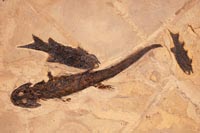 |
280 Million Year Old Amphibian and Two Fish. On the same 16 x 12 inch matrix is a 280 million year old remarkably well preserved early amphibian, Sclerocephalus hauseri as well as two primitive fish. This rare museum quality early amphibian is over 11 inches long and nearly complete with a well detailed 1.75 inch wide arrow shaped skull with a lower jaw filled with tiny sharp teeth and detailed light and dark brown patterned skin impressions along the entire body. Only one of the four feet and a few small leg bones and digits are missing. The two primitive fish Paramblypterus sp. are 6 inches and 3.5 inches long and preserved with their skin and heterocercal fins that are somewhat shark-like. Skin impressions are rare as they are soft tissue and even the texture of the skin is detectable in these impressive fossils. Multiple species preserved together is extremely rare and scientifically important. These museum quality fossils come from the Odernheim Pfatz in Germany from a quarry that has been closed since 1984.
Add $50 for domestic shipping.
Estimated Value $2,200 - 2,900.
View details and enlarged photo
| Unsold |
Lot 965 |
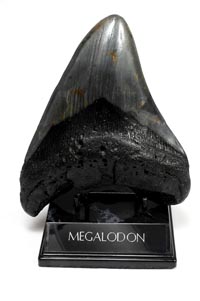 |
Carcharodon Megalodon Shark's Tooth. Even though Carcharodon megalodon was the largest shark that ever lived, growing to more than 50 feet in length, most of the teeth found are only 3-4 inches in length. Teeth over 5 inches in length are in great demand and the magic number is a full 6 inches, which is the size that every collector aspires to own. This immense 6.3 inch 15 million year old Carcharodon tooth was found in the muddy river waters of South Carolina. Estimating the length of a shark at about 10 feet in length to every one inch of tooth, this behemoth would be over 60 feet long. Tooth has a complete black root and blue-gray enamel with a few specks of orange and just a couple of edge nicks repaired on the blade. There are no serrations on the edge. The blue-gray colored enamel contrasts nicely with the black root. Comes with a custom wooden stand.
Add $20 for domestic shipping.
Estimated Value $1,250 - 1,500.
View details and enlarged photo
| Realized
$915 |
Lot 966 |
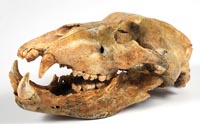 |
Cave Bear Skull. Cave bears were larger than any bear alive today, standing over 10 feet tall. Certainly, the fierceness of their skull bears witness to this. This virtually complete 16 inch long skull has top quality ivory colored bone with a complete upper skull with large 2 inch long canine teeth missing only one of the small front teeth and repair of the zygomatic arch on the right side of the skull. The bottom jaw is missing one of the small front molars as well as three of the front teeth and also part of the thin bone that extends upward from the back of the jaw (this does not show when both the skull and jaw are joined together. Ursus spelaeus lived 50,000-100,000 years ago in Romania and other parts of northern Europe and certainly competed with early man in these areas. The earliest flute-type instrument was made out of a Cave Bear limb bone by Neandertals. Cave Bear skulls are in great demand because the few skulls found are usually mounted with the rest of the skeleton to bring many thousands of dollars. This is an opportunity to acquire an impressive skull with a few defects without paying over $6,000.
Add $50 for domestic shipping.
Estimated Value $2,500 - 3,500.
View details and enlarged photo
| Unsold |
Lot 967 |
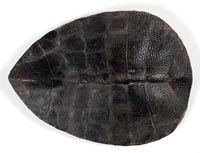 |
Complete Anosteria Turtle. Anosteria maomingesis was a turtle that lived in the Guandong Province of China 45-50 million years ago. All specimens found have been somewhat flattened usually missing some shell and rarely having any of the underside plastron shell preserved. This fairly large 7.75 x 5.75 inch museum quality specimen is the exception even though somewhat flattened has 100 % complete shell on the top and even a good amount of the plastron shell on the bottom. The dark brown shell preserves the 3-D pattern of the shell which in most specimens is worn mostly smooth. All in all a very attractive turtle that is somewhat rare as a fossil and missing from most collections.
Add $20 for domestic shipping.
Estimated Value $500 - 750.
View details and enlarged photo
| Realized
$425 |
Lot 968 |
 |
Complete Finger of Huge Ground Sloth. Ground sloths in North America grew to great size before becoming extinct. Paramylodon harlani was more than 7 feet tall at the hips, weighed almost 2 tons and lived 1-2 million years ago in Alachua County, Florida. This gigantic rare black 10 inch long finger has a 5.25 inch slightly curved claw missing just a small part of the tip plus three finger bones. This huge claw was the largest of the four hand claws and used for defense against predators and to dig up roots. Paramylodon also had small dermal bones embedded in its skin for additional protection against predators. Paramylodon could stand upright and was mostly a vegetarian but it also occasionally ate meat. Ground sloths also have an important place in the history of paleontology in the U.S. as President Thomas Jefferson wrote a letter in August, 1796 about a large claw that he found from a ground sloth; this extinct animal was named after him, Megalonyz jeffersoni and marked the beginning of vertebrate paleontology in the United States. Housed in a 12 x 8 inch Riker Mount.,
Allow $25 for domestic shipping.
Estimated Value $650 - 800.
View details and enlarged photo
| Unsold |
Lot 969 |
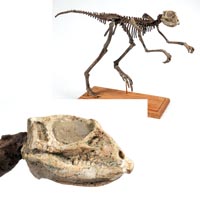 |
Complete Mounted Dinosaur. This 22 inch long important dinosaur Jeholosaurus is between 130-135 million years old from Central Asia, has over 80% real bone and has been professionally mounted in a life-like walking position. All of the small delicate bones have been micro-drilled with small rods inserted inside the bones to give a realistic 3D free standing specimen with the only visible rods being at the bottom of the feet. The bone quality is excellent with the only restoration done on the ribs and some of the small neural spines along the back and tail. The important 2.5 inch skull is complete with real teeth on both the upper and lower jaws on one side and several tips of teeth visible on the other side of the skull. There could be some more teeth under this other side but they may be obscured because the skull has shifted a little bit to one side. The eye of the skull is huge being one inch in diameter and even though this specimen is a juvenile, it probably indicates that Jeholosaurus was a nocturnal dinosaur that hunted insects at night. The large back legs with large feet show that Jeholosaurus was a very fast running dinosaur. It was bipedal and the fingers on the hands are displayed in a natural curved postion with sharp little claws which they may have used to dig in the ground for insects.
Jeholosaurus belongs to a little know taxa of dinosaurs know as Heterodontosauridae. These small supposedly plant eating dinosaurs are very eary Ornithipods and are little understood because so few of them have been discovered. Just recently a slightly older but similar Heterodontosauridae known as Tianyulong was found in Liaoning, China as is important as it was clearly feathered with short small feathers. This means that its slightly later ancestor Jeholosaurus would also have been feathered. This is extremely important as no Ornithipod or plant eating dinosaur had ever been found that had feathers. Only some theropod, meat eating dinosaurs have been found to have feathers. Thus, Jeholosaurus is a missing link animal that bridges the feather gap of Ornithipod and Theropod dinosaurs. Jehosaurus is from the early Cretaceous of over 130 million years ago and was found in the tuffaceous volcanic sandstone of the lower Yixian formation in Liaoning Province of Central Asia. Even the teeth of Jeholosaurus look like a cross between a meat eating and plant eating dinosaur with sharp pointed teeth in the front of the jaw and flat teeth in the rest of the jaw like a plant eating dinosaur. Perhaps they were omnivores eating both plants and insects and possibly small lizards.
This 22 inch long 11 inch high juvenile Jeholosaurus has been mounted on a 10.5 x 4 inch wooden base for display and a glass or acrylic clear case can be easily obtained for display if desired. The dinosaur comes apart in seven pieces for easy transportation and examination. The skull can be easily taken on and off for study. This is an important opportunity to buy a complete dinosaur at a reasonable price as very few collectors can ever hope to own a real complete dinosaur without paying hundreds of thousands of dollars.
Add $125 for domestic shipping.
Estimated Value $14,000 - 18,000.
View details and enlarged photo
| Unsold |
Lot 970 |
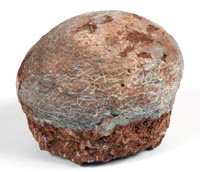 |
Dinosaur Egg Museum Quality. This huge complete fully inflated unhatched Duckbill dinosaur egg is 70-80 million years old 7 x 6 inches and of museum quality with over 85 percent of its original shell intact. The egg is completely original and is mostly brown and gray in color with just some patches of reddish brown matrix peaking through. We do not know to what Duckbill species this egg belongs as no embryonic bones have every been found in the Duckbill dinosaur eggs, but being the largest Duckbill egg at a gigantic 7 inches in length (most eggs being 5-5.5 inches long) it might belong to the huge Duckbill dinosaur Shantungosaurus which reached more than 50 feet in length and has been found in the same area in the Henan Province of China. This museum quality dino egg makes an excellent display having much more original egg shell than normally found and still standing on a small section of its reddish brown limestone matrix. Dinosaur eggs are becoming hard to locate and rising sharply in value.
Add $25 for domestic shipping.
Estimated Value $600 - 900.
View details and enlarged photo
| Unsold |
Lot 971 |
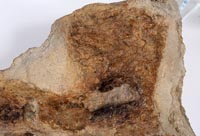 |
Dinosaur Skin With Soft Tissue. Dinosaur skin is the rarest and most coveted of dinosaur fossils because of its extreme rarity being preserved only under extraordinary conditions. The dinosaur had to have been completely covered by fine mud sediments probably in a large river delta within a day or so after dying to avoid bacterial breakdown of the skin and soft tissue which would occur immediately. This type of extreme condition may have occurred in a massive flood. The skin texture was impressed in detail in the soft clay forming a natural mold which was later filled by more muddy sand creating a natural cast and remained intact for over 65 million years even after the skin and other soft tissue was destroyed by bacteria. This large section of dinosaur skin is from the back of the hip or tail section of an Edmontosaurus duckbilled dinosaur and is between 65-70 million years old and was found along with some fragmented Edmontosaurus bones in the Hell Creek Formation of Montana. Also, soft tissue has also been fossilized along with the skin. The soft tissue could be muscle or glands but it is something that was just beneath the skin. The answer might be coming soon as a more complete Edmontosaurus with soft tissue has been found and was featured on a National Geographic Show titled "Dinosaur Autopsy " with a book coming out later this year.
This large section of matrix is 10.5 x 7 inches and has skin impressions on both sides of the limestone rock. The best detailed skin is 4 x 4 inches showing excellent detail with a large 8 x 2 inch skin section curving beneath it. Also present on the bottom of this 8 x 2 inch skin section is a 2.5 x 2 inch dark brown imprint of the muscle or gland that was present just beneath the skin. On the back of the slab is another 5 inch long skin impression area that varies in thickness from 1-3 inches. All of the color is original just as found when the rare specimen was broken out of a larger piece of rock. The Dinosaur Autopsy show called their find the most important of the decade and an offering of dinosaur skin with soft tissue preservation may never be offered for sale again.
Add $30 for domestic shipping.
Estimated Value $1,300 - 1,600.
View details and enlarged photo
| Unsold |
Lot 972 |
 |
Fossil Walrus Baculum. A small number of mammals possess an unusual bone, the baculum which is a penile bone. Baculum are possessed by seals, sea lions, bears and the walrus. The Walrus Baculum is the largest of all as represented by this huge 20.5 inch long, 1.5 inch wide complete specimen from Alaska. This 5,000-10,000 year old fossil bone is from a very large male Walrus from the species Odobenus romanus. The Yupik Eskimos call the Walrus Baculum an oosik and have used these large bones both as clubs and to carve images like scrimshaw.
Add $20 for domestic shipping.
Estimated Value $400 - 600.
View details and enlarged photo
| Unsold |
Lot 973 |
 |
Huge 12.5 Inch Long 50 Million Year Old Trout. Mioplosus labracoides was an extinct relative of modern day trout. It is over 50 million years old from the famous Green River Formation near Kemmerer, Wyoming. Mioplosus was a predatory fish that had two dorsal fins and a fan-like tail. This huge 12.5 inch long fossil is one of the largest found for this species and is virtually complete with excellent detail in the head, body and fins. The 3.5 inch head is a beautiful very dark brown color even with sharp little teeth in both the upper and lower jaws. The rest of the body is a lighter chocolate brown color with complete vertebrae and spines with just the tips of some of the delicate spines restored. The 18 x 7.5 inch limestone matrix has been backed with wood and even has a hook for hanging if so desired. Small fish are common from the Green River formation but large fish such as this Mioplosus are in great demand from both collectors and interior decorators for hanging on the wall.
Add $30 for domestic shipping.
Estimated Value $400 - 500.
View details and enlarged photo
| Realized
$336 |
Lot 974 |
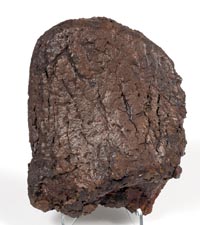 |
Huge Armored Dinosaur Scute. Ankylosaurus was the largest armored dinosaur (up to 30 feet long) looking something like a tank on legs with large osteoderms (scutes) covering its entire upper body and also a club on its tail which was also formed by combining a number of osteoderms joined together. Even though Ankylosaurus is a very famous dinosaur, no complete specimens have ever been found. Mostly just broken armored scutes are found. This lot contains one of the largest solid complete back scutes found being 5 x 4.5 inches. This osteoderm was even larger in life being covered in tough horny keratin (the same substance that covers our fingernails. This chocolate brown osteoderm is greatly detailed with ridges that allowed blood to flow into the bone and has some expert restoration on one of the sides that exactly matches in both color and texture. This unusual fossil was found in the 65-66 million year old Hell Creek Formation on private land of West-Central South Dakota.
Add $20 for domestic shipping.
Estimated Value $400 - 500.
View details and enlarged photo
| Realized
$390 |
Lot 975 |
 |
Kueichousaurus Skeleton. Kueichousaurus hui was the 240 million year old ancestor from Guizhou Province, China of the famous long necked sea reptiles Plesiosaurus which was made famous as being the mysterious Loch Ness monster. Kueichousaurus also lived in the ocean and had a long, flexible neck, tiny sharp teeth, webbed feet and a tail as long as its neck. This 9.5 inch long excellent 3-D fossil (an adult) has well defined bones and an excellent skull preserved upside down with the delicated bottom jaws preserved with even some of the small pointed black teeth and is well positioned on a 12 x 5 inch dark grey slate matrix with a natural white calcite vein and a barely noticeable repaired break in the matrix. All of the bones present are of top quality with all four legs present, but some of the toe bones and claws are missing although the tail is complete, which is rare.
Add $20 for domestic shipping.
Estimated Value $400 - 600.
View details and enlarged photo
| Unsold |
Lot 976 |
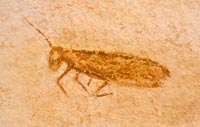 |
Large Fossil Grasshopper. Usually only small insects are found in the fossil record. Large insects such as this 2.9 inch Grasshopper (Locust) are extremely rare. Also, it is one of the earliest insects known at over 150 millions from Eichstatt, Germany. Eichstatt is a sister fossil lagoon to Solnhofen which is famous for the fossil of the earliest bird, Archaeopterix. The best insects are found in the Eichstatt fossil pond which was shallow and preserved a very small representation of large flying insects. All fossils from this lithographic limestone are rare and many tons of limestone have to be processed to find a rare fossil. This 2.9 inch locust (including the antennae) is nearly complete with four legs and head with a clear eye and one of the antennae. It is nicely centered on a 5.75 x 4.75 inch natural limestone matrix.
Add $20 for domestic shipping.
Estimated Value $400 - 500.
View details and enlarged photo
| Unsold |
Lot 977 |
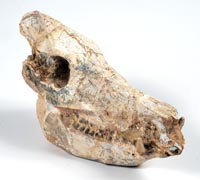 |
Mammal Fossilized Pig Skull. Fossilized pigs are rarely encountered in the fossil record. Pigs have very distinctinve skulls because their large canine teeth are found on their lower jaw instead of the upper jaw. These teeth enable them to root out bulbs and roots underground. This 15-20 million year old pig skull belongs to Chlieutochoerus stehlini and was found in the Bahean strata of Gansu in North Central China. The light cream colored skull measures 10 x 4 inches with one inch Canines and has just a little restoration to one side of the back of the skull as well as some of the teeth being placed back into the jaw with one of the canine teeth missing its tip. Some of the matrix has been left in the lower jaw to enable the skull to be free standing. This is a very rare fossil pig that is seldom offered for sale.
Add $30 for domestic shipping.
Estimated Value $1,600 - 2,000.
View details and enlarged photo
| Unsold |
Lot 978 |
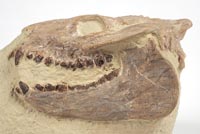 |
Merycoidon Mammal Skull in Original Matrix. Merycoidon gracilis was a strange 30 million year old mammal from the extinct oreodont mammal group that has no modern relative and had some features of a pig and some features of a deer. This original 5 x 3 inch long skull is still preserved in its original cream colored limestone stone matrix with the skull and lower jaw being complete with excellent quality contrasting brown teeth. The right side lower jaw is not exposed out of the matrix and may still be present in the rock. The limestone base has been flattened to make a dramatic display. This completely original fossil with no restoration was found on privately owned land in the White River Badlands formation of Sioux County, Nebrasca.
Allow $30 for domestic shipping.
Estimated Value $550 - 750.
View details and enlarged photo
| Realized
$472 |
Lot 979 |
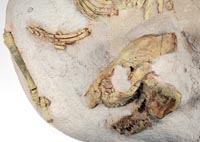 |
Mesohippus Horse Fossil. Mesohippus bairdi was a very small, two foot tall 30 million year old horse. Horses were native to North America and Mesohippus was an early member of the perissodactyl horse which had three hooves on each foot. This original limestone block is 20 x 18 inches and contains a 40-50 % complete in situ skeleton still in the same position as found in the White River Badlands Formation of South Dakota. This completely original fossil contains a 7 x 4.5 inch horse skull that is nearly complete with an excellent upper skull with most of the teeth present on the side that has been prepared on the top of the matrix and one near complete lower jaw with dark brown teeth that is slightly disarticulated making analysis of the teeth easier. In addition much of the body (14 inches) with 12 ribs and many vertebrae and even two long leg bones (8 and 6 inches long) are present. This is a rare opportunity to own and examine an important extinct horse with an original in situ specimen that has been professionally prepared by many hours of detailed work to create such a stunning museum quality specimen
Add $100 for domestic shipping.
Estimated Value $2,250 - 3,250.
View details and enlarged photo
| Unsold |
Lot 980 |
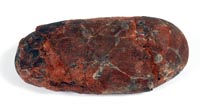 |
Museum Quality Oviraptor Egg. This original unhatched Oviraptor egg is 70-80 million years old from the Djadokhta formation of Ukhaa Tolgod of Mongolia. This egg was found in the Gobi desert and is 6 inches long and belongs to the largest of the two Oviraptor species called Citipati to distinguish this difference from the other smaller species. Citipati Oviraptorids were made famous by the nest of eggs with the mother Citipati sitting on top of the eggs in a brooding position. This famous specimen is displayed in the New York Museum of Natural History and was discovered in 1995. It was revolutionary to discover a dinosaur sitting on top of its eggs like a bird and only later was it discovered that Oviraptors such as Citipati also had feathers like a bird. Citipati eggs are ratite in texture and have a very thin shell which is why they are rarely found complete. This premium quality egg has sharp textured detail on the shell with over 90% original shell and may still have embryonic bones at the bottom inside of the unhatched egg. A paleontologist examined this egg and did find some small bone fragments on the bottom side in the gaps where there is not shell. The only way to be certain would be to slowly etch the egg from the top to see exactly what bones are still inside. Typically, about 20% of the unhatched Oviraptor eggs contain some embryonic bones. The bones are always disarticulated and usually are jumbled together in a small area. This egg is special even if there are not any more bone fragments because of the amount of shell and because it is not crushed or flattened like most of the Oviraptor eggs available.
Allow $20 for domestic shipping.
Estimated Value $900 - 1,200.
View details and enlarged photo
| Unsold |
Lot 981 |
 |
Pair of Fossil Crabs. Archaeoperyon puruvianus was a 25 million year old fossil crab from Argentina. What makes this fossil special is that there are two large crabs the largest being 8 inches and the smaller one 6.5 inches long side by side as found in their original 14.5 x 5 inch stone matrix. Both crabs have complete carapaces and large claws with only the ends of some of the legs missing. There was a crack in the matrix that has been repaired but it does not affect the fossils. It is very unusual to find two crabs together in the same matrix and this makes for an impressive display.
Allow $30 for domestic shipping.
Estimated Value $650 - 850.
View details and enlarged photo
| Unsold |
Lot 982 |
 |
Pair of Golden Russian Ammonites. Some of the most beautiful ammonites come from a small 150 Million year old section of the Volga River in the Ulianosk area of Russia. These Spiticeras species ammonites are so highly valued because of their fossilization. When the ammonite is cut in half, many of the chambers are filled with glittering pyrite also know as fools gold. This lot consists of a very large 9.75 inch diameter complete ammonite that has been cut in half revealing both open inner chambers filled with pyrite as well as some outer chambers filled with yellow calcite. The very last living chambers are black with some outer edges of pyrite. Even the individual chambers are separated by bands of golden pyrite. Both halves of this lovely ammonite are included with stands for display.
Allow $25 for domestic shipping.
Estimated Value $1,000 - 1,500.
View details and enlarged photo
| Realized
$826 |
Lot 983 |
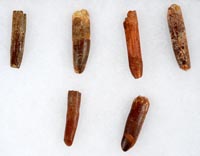 |
Six Sauropod Teeth. Sauropods were the largest dinosaurs that ever lived growing to over 100 feet long. These behemoths were plant eating giants with small heads and extremely long necks. Rebbachisaurus was a 100 million year old 70 foot long sauropod found in the Sahara desert of Africa. What distinguishes the titanosaur from the other sauropods is that it had tall spines on its back which may have supported a hump or sail. It was similar to some other titanosaurs from South America that offers support that South America and Africa were still joined together at this time. These six peg-like teeth are 1.5-2 inches long which is large for sauropods. These teeth were used to just rip vegetation from the branches of trees and were not made for chewing as the greens were just swallowed whole. This collection is housed in a 8 x 12 inch Riker mount.
Add $20 for domestic shipping.
Estimated Value $600 - 900.
View details and enlarged photo
| Unsold |
Lot 984 |
 |
Spinosaurus Foot Claw and Toe Bone. Made famous in "Jurassic Park III" as the dinosaur that killed a T-Rex, the enormous theropod dinosaur Spinosaurus with a huge sail on its back remains an enigmatic dinosaur as no even remotely complete skeleton has ever been found and the only partial skeleton was destroyed in World War II. Spinosaurus is mostly known from its teeth which are fairly common but usually broken and ugly. Claws are rarely found and big claws such as this 3.5 inch complete museum quality foot claw showing all of the bold grooves with a perfect tip and no restoration plus a 1.6 inch phalange are usually only seen in museums. Claws are much rarer than teeth because dinosaurs could replace their teeth but not their claws. This 80 million year old dinosaur claw and toe bone were found in the Kem Kem Valley near Taouz, Morocco. These museum quality fossils are housed in an 8 x 6 inch Riker mount.
Add $20 for domestic shipping.
Estimated Value $1,200 - 1,500.
View details and enlarged photo
| Unsold |
Lot 985 |
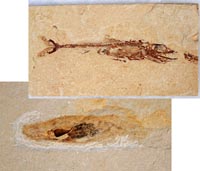 |
Squid and Viper Fish Fossils. Many interesting fish and sea creatures are found in the 100 million year old fossils of Hajoula, Lebanon. This excellent variety of fish occurs because this was a salt water shallow sea 100 million years ago. This lot contains a 5 inch long predatory Viper fish (Europholis sp.) virtually complete with sharp little teeth on the upper jaw and also a 2 inch long squid (Trachyteuthis) that shows excellent detail for a soft bodied animal with a black area that were its last meal as well as the ink sac area which appears as a brown bullet shaped area. There are even faint short stubs of some of the tentacles at one end. Squid fossils are very rare because squid possess no skeletons. Both of these fossils are nicely highlighted on their lighter limestone matrix and displayed in a 14 x 8 inch Riker Mount.
Add $25 for domestic shipping.
Estimated Value $500 - 600.
View details and enlarged photo
| Unsold |
Lot 986 |
 |
T-Rex Tooth in Matrix. All fossils from a T-Rex are rare and in tremendous demand. Large teeth are the most desired of T-Rex fossils. This 66 million year old 2.75 inch tooth was found in the late Cretacious rocks of Drumheller, Alberta. The tooth was professionally prepared and left in a small 2.5 x 1.5 inch stone matrix. for a dramatic display. The 2.75 inch too (measured along the diagonal) has a lovely chocolate brown color, good enamel with some cracks filled and serrations on one of the sides with some tooth wear and minor chips on the tip. Virtually all large T-Rex teeth have cracks and missing enamel that has to be restored. With large T-Rex teeth selling for more than $1500 per inch, this less than perfect large shed tooth should be an excellent inexpensive alternative.
Allow $20 for domestic shipping.
Estimated Value $1,000 - 1,250.
View details and enlarged photo
| Unsold |
Lot 987 |
 |
Three Fossil Feathers and Insects in Amber. This large 2.75 x 1.75 inch clear and loaded amber nugget contains three large bird feathers that are joined together in a long 1.6 inches grouping. Bird feathers preserved in amber are extremely rare and these three feathers are very clear with their delicate veins and barbs well detailed. As an extra bonus this interesting piece of amber is absolutely loaded with insect inclusions including ants, a leafhopper, a winged termite with excellent wing detail, a spider, rove beetles, advanced flies, fungus gnats and many reddish circular globs of fungus. Many hours can be spent examining this loaded piece of amber with a low power magnifying glass and discovering new insects and details. The absolute age of young Colombian amber or copal cannot be determined as amber itself cannot be tested and dated, but from the color and hardness of the golden Colombian nuggets, experts suggest their age to be at least 1-5 million years old or older.
Add $10 for domestic shipping.
Estimated Value $400 - 500.
View details and enlarged photo
| Realized
$1,050 |
Lot 988 |
 |
Two Ammonites From Madagascar. Ammonites were early mollusks that somewhat resembled an octopus or squid living within a protective shell and are the closest relative to the chambered nautilus which still exists today. The name ammonite was given to these fossils thousands of years ago by the Romans as the spirals reminded them of the ram�s horn worn by the Egyptian god Ammon. The scientific name for each species of ammonite ends in "ceras" which is the Greek word for horn. This lot contains both halves of a large 6.25 inch in diameter 110 million year old ammonite, Cleoniceras from the large island of Madagascar. This ammonite has been cut in half and polished to reveal the detail and beauty of the inner chambers. Ammonites started growing in the small center and added chambers spiraling outward as they grew. The living animal lived only in the last large chamber and the inner chambers were airtight and could be filled with water or air by the living ammonite using its tube-like Siphuncle to move up or down in the water. The beautiful large 6.25 inch ammonite has the outer chambers filled with white calcite with all of the inner chambers filled with several different colored minerals ranging from beige to browns. Also included is a compete brown 6 inch Cleoniceras that has been polished to reveal the intricate suture pattern that gave the thin shell extra strength. This lot contains three specimens.
Allow $25 for domestic shipping.
Estimated Value $400 - 500.
View details and enlarged photo
| Realized
$531 |
Lot 989 |
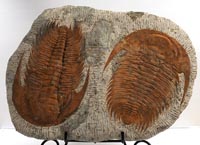 |
Two Gigantic Trilobites. There are two giant Acadoparadoxites trilobites on a 25 x 16 inch matrix. Acadoparadoxites was one of the largest and very earliest trilobites (over 500 million years old) that ever lived. This gigantic trilobite was one of the largest predators of the mid Cambrian warm seas of Morocco. Found in the Atlas Mountain range of Morocco, these 12 x 9 and 11.75 x 9.75 inch trilobites have an attractive rust orange color, limonite (an iron oxide) which nicely contrasts with the creamy matrix. Both trilobites are virtually complete with only minor restoration on a few of the spines on the pygidium. With most trilobites being only an inch or so in length, finding a museum quality specimen of such giant trilobites is a very rare occurrence.
Add $50 for domestic shipping.
Estimated Value $500 - 700.
View details and enlarged photo
| Realized
$390 |